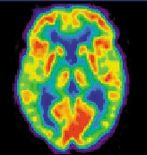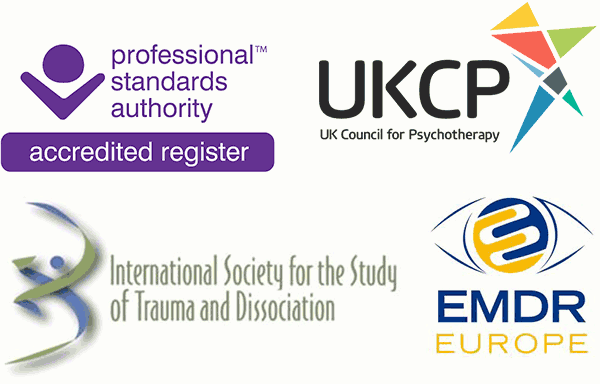Qualifications, Experience, Professional Membership and EMDR
"I never let my schooling interfere with my education"
Mark Twain
Qualifications
- MSc Psychological Trauma (Distinction) 2011
- EMDR EUROPE Accredited Consultant and Facilitator. EMDR is recognised by NICE ( The National Institute for Health & Care Excellence) as an effective psychological therapy for trauma and is also effective for anxiety, phobias, depression and grief.
- MSc Psychology 2004
- Diploma in Counselling Supervision - 2000
- Diploma in Gestalt Psychotherapy - 5 year training - 1991
- BSc (Hons) Psychology 1983
Professional Membership
- Accredited EMDR Europe Consultant and Facilitator and member of EMDR UK .EMDR
- Registered Psychotherapist UK Council for Psychotherapy UKCP - National registering body holds directory of registered psychotherapists in UK.
- Graduate Member of British Psychological Society BPS - open to holders of academic psychology qualifications.
- Professional Member of the International Society for the Study of Trauma and Dissociation ISSTD - Specialist organisation promoting research and good practice in the field of psychological trauma.
Experience
- 2014 to date EMDR EUROPE Accredited Consultant
- 2012 to date full time private practice offering psychotherapy, trauma counselling, EMDR, supervision and training.
- 2018 to 2022 Consultant Facilitator with EMDR ACADEMY EMDR ACADEMY
- 2019 to 2025 Director Brightstone Clinic, Sandbach, Cheshire, CW11 1BA. A clinic offering therapeutic spaces for psychological and complementary practitioners.
- 2022 to 2025 Director of Hope Street Social CIC a social enterprise offering community events; women's therapy group for Ukrainian Refugees; Autism and ADHD Mentoring and low cost therapyto local community.
- 2012 to 2016 Director of Brightstone CIC a social enterprise offering low cost therapy and placements for therapists in training.
- 2000 to 2012 - Psychotherapist and Clinical Supervisor Cheshire and Wirral Partnership NHS Foundation Trust (CWP). Assessment and treatment of complex trauma in adults.
- 1991 to 2000 - Private Psychotherapy Practice, London.
- 1992 to 1995 - Social Researcher and Executive Officer, The Bishops of London Social Responsibility Committee (The London Churches Group).
- 1990 to 1992 - Director, Islington MIND.
- 1987 to 1990 - Deputy Director/Training CoOrdinator, St.Martin of Tours Specialist Housing Association for Ex- Offenders.
- 1985 to 1987 - Project Manager, Therapeutic Community for Recovering Alcoholics, The Richmond Fellowship.
- 1983 to 1985 - Trainee Scholar, Therapeutic Community for Adults, The Richmond Fellowship.
Special Interests - Regular contributor to the EMDR Quarterly Journal reviewing books and conferences.
- Member of EMDR UK and Ireland North West Regional Committee from 2012 till 2014
- Facilitator of South Cheshire and Stoke EMDR Support Group from 2012 to 2016
- Member of EMDR UK & I Post Traumatic Growth and Resilience Special Interest group.
- Member of UKAHPP Board of Directors from 2010 till 2012
- Member of UKAHPP Ethics Committee from 2010 till 2014
EMDR Efficacy Research compiled and approved by Robin Logie, President of EMDR UK and Ireland.
What is EMDR?
EMDR stands for Eye Movement Desensitisation and Reprocessing - a powerful psychological therapy originally developed to treat post-traumatic stress disorder (PTSD). It is a complex discipline and should only be practised by qualified and highly experienced therapists.
What does it involve?
EMDR helps people to process traumatic memories so that they are no longer disturbing. The eye movements in EMDR therapy appear to help the brain to do this processing in much the same way as they help process the day’s experiences during sleep.
EMDR therapy also helps people to explore how they think about past traumas and how to make sense of them. The ultimate aim of EMDR is to reduce the disturbance generated by traumatic memories so that people can live their lives more fully.
Who can benefit from EMDR therapy?
Research shows that EMDR is effective in treating a diverse range of psychological trauma. Survivors of armed conflict, childhood abuse and neglect, natural disasters, assault, road-traffic and workplace accidents have all reported recovery and improved wellbeing as a result of EMDR therapy.
EMDR is also increasingly helping people to manage other psychological issues ranging from depression to performance anxiety. It has been found to be of benefit to children as well as adults.
How do patients access EMDR therapy?
EMDR therapists work within the NHS, other agencies and in private practice. People may be referred for EMDR therapy by their GP or other medical practitioner or can refer themselves. Solicitors acting for clients in personal injury cases may also refer clients for EMDR. You can find the EMDR Association at: www.emdrassociation.org.uk
How long has it been in existence as a therapy?
EMDR was developed by an American clinical psychologist, Dr Francine Shapiro, in the 1980s.
How many EMDR practitioners are there in the UK?
Several thousand EMDR practitioners have been trained in the UK. The UK & Ireland Association has about 1,000 members. The UK & Ireland Association, in collaboration with EMDR Europe, has a system of accreditation for EMDR therapists.
Is this a recognised therapy/treatment?
EMDR is recognised by NICE (National Institute for Health and Clinical Excellence) as a treatment for PTSD.
How does it differ from CBT (cognitive behavioural therapy)?
Whilst EMDR incorporates elements similar to CBT and other forms of psychotherapy, it is itself a distinct psychotherapy guided by a model and protocols. EMDR tends to go further than CBT in accessing and reprocessing early traumatic memories on several levels. Most research that compares the EMDR and CBT shows them to be equivalent although a few studies have shown that EMDR is more effective and requires fewer sessions.
Posttraumatic Stress Disorder (PTSD)
EMDR has been well established as an effective treatment for PTSD. A recent survey of 38 randomised clinical trials (RCT) established that EMDR and Trauma Focussed Cognitive Behaviour Therapy (TFCBT) are the two most effective treatments for this disorder [1].
A review of the efficacy of EMDR for children with PTSD (7 studies) showed EMDR and Cognitive Behaviour Therapy (CBT) to be superior to all other treatments. EMDR was found to be slightly more effective when compared directly with CBT [2].
The International Society for Traumatic Stress Studies current treatment guidelines have designated EMDR as an effective and empirically supported treatment for PTSD, and has given an “A” rating for adult PTSD [3]. The American Psychiatric Association Practice Guideline has stated that EMDR is one of the three recommended first-line treatments for trauma [4]. In the UK, EMDR is one of the two recommended treatments for PTSD in the guidelines of the National Institute of Clinical Excellence (NICE) [5].
Other disorders
Research into EMDR with other disorders is at an earlier stage of development.
There are published RCTs showing the effectiveness of EMDR with survivors of sexual abuse [6]. One study showed EMDR to be significantly more efficient, using approximately half the number of sessions to achieve results as compared with CBT [7].
In another RTC, EMDR resulted in large and significant reductions of memory-related distress, and problem behaviours in boys with conduct problems [8].
Many other studies have been published regarding the efficacy of EMDR for other disorders in non-randomised studies. These include:
- Depression. Generally the study of the reduction of depressive symptoms using EMDR has been a secondary measure in post traumatic stress studies many of which have shown reductions of depression with EMDR. Some studies have specifically shown EMDR as an effective treatment for depression [9] [10].
- Borderline Personality Disorder [11]
- Body Dysmorphic Disorder [12]
- Generalized Anxiety Disorder [13]
- Pain Management [14]
- Paedophilia [15]
- Phantom Limb Pain [16] [17] [18]
- Bulimia Nervosa [19]
- Phobia [20]
- Obsessive Compulsive Disorder (OCD) [21]
Further information
More details about research into EMDR can be found as follows:
EMDR Institute:
www.emdr.com/efficacy.htm
Francine Shapiro Library:
www.emdr.nku.edu
References
1.
Bisson, J., et al., Psychological treatments for chronic post-traumatic stress disorder. Systematic review and meta-analysis. British Journal of Psychiatry, 2007. 190: p. 97-104.
2.
Rodenburg, R., et al., Efficacy of EMDR in children: A meta-analysis. Clinical Psychology Review, 2009. 29: p. 599-606
3.
Foa, E., et al., Effective treatments for PTSD: Practice Guidelines of the International Society for Traumatic Stress Studies 2009, New York: Guilford Press.
4.
American Psychiatric Association, Practice Guideline for the Treatment of Patients with Acute Stress Disorder and Posttraumatic Stress Disorder. 2004, American Psychiatric Association Practice Guidelines: Arlington, VA.
5.
National Institute for Clinical Excellence, Post Traumatic Stress Disorder (PTSD): The Management of Adults and Children in Primary and Secondary Care. 2005, NICE Guidelines: London.
6.
Edmond, T., A. Rubin, and K. Wambach, The effectiveness of EMDR with adult female survivors of childhood sexual abuse. Social Work Research, 1999. 23: p. 103-116.
7.
Jaberghaderi, N., et al., A comparison of CBT and EMDR for sexually abused Iranian girls. Clinical Psychology and Psychotherapy, 2004. 11: p. 358-368.
8.
Soberman, G., R. Greenwald, and D. Rule, A controlled study of eye movement desensitization and reprocessing (EMDR) for boys with conduct problems. Journal of Aggression, Maltreatment, and Trauma, 2002. 6: p. 217-236.
9.
Bae, H., D. Kim, and Y. Park, Eye movement desensitization and reprocessing for adolescent depression. Psychiatry Investigation, 2008. 5: p. 60-65.
10.
Rosas, U., R. Lopez, and M. Jarero, Effect of the EMDR psychotherapeutic approach on emotional cognitive processing in patients with depression. The Spanish Journal of Psychology, 2010. 13: p. 399-405
11.
Brown, S. and F. Shapiro, EMDR in the treatment of borderline personality disorder. Clinical Case Studies, 2006. 5: p. 403-420.
12.
Brown, K., T. McGoldrick, and R. Buchanan, Body dysmorphic disorder: Seven cases treated with eye movement desensitization and reprocessing. Behavioural and Cognitive Psychotherapy, 1997. 25: p. 203–207.
13.
Gauvreau, P. and S. Bouchard, Preliminary evidence for the efficacy of EMDR in treating generalized anxiety disorder. Journal of EMDR Practice and Research, 2008. 2: p. 26- 40.
14.
Ray, A. and A. Zbik, Cognitive behavioral therapies and beyond, in Practical Pain Management (3rd ed), C. Tollison, J. Satterhwaite, and J. Tollison, Editors. 2001, Lippincott: Philadelphia. p. 189-208.
15.
Ricci, R., C. Clayton, and F. Shapiro, Some effects of EMDR treatment with previously abused child molesters: Theoretical reviews and preliminary findings. Journal of Forensic Psychiatry and Psychology, 2006. 17: p. 538-562.
16.
Russell, M., Treating traumatic amputation-related phantom limb pain: a case study utilizing eye movement desensitization and reprocessing (EMDR) within the armed services. Clinical Case Studies, 2008. 7: p. 136-153.
17.
Schneider, J., et al., EMDR in the treatment of chronic phantom limb pain. Pain Medicine, 2008. 9: p. 76-82.
18.
Wilensky, M., Eye movement desensitization and reprocessing (EMDR) as a treatment for phantom limb pain. Journal of Brief Therapy, 2006. 5: p. 31-44.
19.
Kowal, J.A., QEEG analysis of treating PTSD and bulimia nervosa using EMDR. Journal of Neurotherapy, 2005. 9: p. 114-115.
20.
De Jongh, A., E. Ten Broeke, and M. Renssen, Treatment of specific phobias with Eye Movement Desensitization and Reprocessing (EMDR): protocol, empirical status, and conceptual issues. Journal of Anxiety Disorders 1999. 13: p. 69–85.
21.
Böhm, K. and U. Voderholzer, Use of EMDR in the treatment of obsessive-compulsive disorders: a case series. Verhaltenstherapie, 2010. 20: p. 175–181.
Robin Logie
EMDR Association UK & Ireland
2011
Recovery * Resilience * Growth





